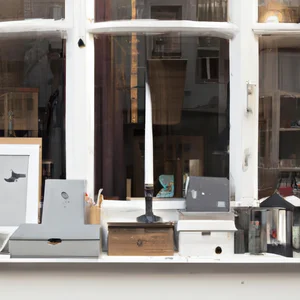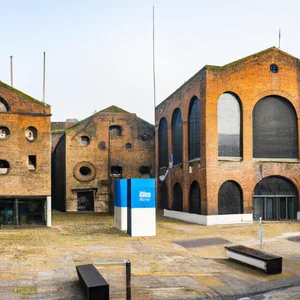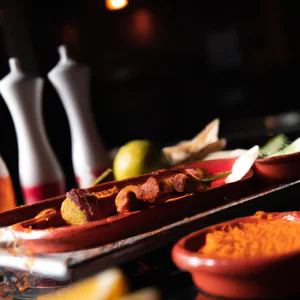Book your experience
Multi-ethnic cuisine in London
Hi everyone! So, let’s talk a bit about multi-ethnic cuisine in London, which is crazy, I tell you! If you think about it, it’s as if every corner of the city was a small piece of the world, and I assure you that the food is living proof of this.
But, well, London is a real melting pot, right? Every time I take a tour around the various neighborhoods, I feel like I’m traveling without even having to take a plane. For example, I once went to Brixton, and I tell you that the atmosphere was so vibrant, almost like I was in a market in Dakar. There were scents of spices that enveloped you, and I found myself eating Jamaican food that was the bomb! Seriously, the jerk chicken was so good I almost started dancing.
And then, what about Shoreditch? It’s kind of the hipster neighborhood of the city, and I tried an Ethiopian restaurant there. I wasn’t sure, eh, but I said to myself: “Why not?”. And so I tasted injera, a fermented bread that practically serves as a plate and cutlery. It was a stroke of genius, because eating it with your hands makes you feel a bit like an explorer – a truly unique experience!
In short, every community brings with it a story, and food is their way of telling it. It’s like each dish is a chapter in a huge book, and I’m, well, I’m something of a hungry reader. And I’m not even exaggerating!
Of course, there are also places that aren’t worth much, but in the end, it’s all about trying and experimenting. Maybe a Chinese restaurant disappoints you, but then you find an Indian stand that makes you say “Wow, this is the best curry I’ve ever tasted!”
So, if you happen to find yourself in London, do yourself a favor: don’t limit yourself to the usual places. Immerse yourself in the gastronomic tour of the international communities, because that is where you discover the true culinary treasures. And who knows, maybe it will take you on an epic adventure, just like it happened to me!
Multi-ethnic cuisine in London: food tour of the city’s international communities
Explore ethnic markets: hidden gastronomic treasures
Walking among the colorful stalls of Borough Market, my mind was immediately captivated by the enveloping scents and the lively chatter of the sellers. There is nothing more fascinating than getting lost in this labyrinth of flavours, where every corner tells a different story. I remember one afternoon when I came across a small stall run by an Indian family, who prepared fresh samosas flavored with secret spices. Each bite was a journey to a distant world, an experience that transformed my perception of ethnic food in London.
London’s ethnic markets aren’t just places to buy ingredients; they are real treasure chests of culture and tradition. Brick Lane, for example, is famous for its Sunday markets, where you can find products from all over the world, from Indian spices to Turkish sweets. According to local tourism agency Visit London, these markets offer a variety of culinary experiences that reflect the city’s diversity.
Insider tip
A little-known tip: at Greenwich market, look for Jamaican food stalls. Here you will find not only delicious dishes, but also the opportunity to chat with the vendors, who often share family recipes and stories, making the experience even more authentic.
Cultural impact
The presence of ethnic markets in London is a reflection of the city’s history as a crossroads of cultures and traditions. Since the 18th century, London has welcomed migrants from all over the world, bringing their eating habits with them. Today, these markets are not only a way to enjoy exotic dishes, but also an opportunity to understand and celebrate the different cultures that make up London’s social fabric.
Sustainability
Adopting sustainable tourism practices is critical to the health of ethnic markets. Many vendors are committed to using local and organic ingredients, thus contributing to a circular and sustainable economy. Choosing fresh, seasonal produce not only enriches the palate, but also supports local communities.
An experience worth trying
If you want to fully immerse yourself in this gastronomic adventure, take a guided tour of London’s ethnic markets. Several agencies, such as Street Food Tours, offer experiences that will take you to explore not only the food, but also the stories of the communities that produce it. It’s a unique opportunity to savor a plate of pani puri or a portion of jollof rice while hearing fascinating stories from the vendors.
Myths to dispel
A common misconception is that street food is necessarily low quality. In fact, many of the dishes you’ll find at ethnic markets are prepared with fresh ingredients and follow recipes passed down from generation to generation. The passion and love for cooking that many vendors put into their dishes is evident in every bite.
Final reflection
Next time you’re in London, take a moment to explore the ethnic markets. I invite you to reflect on how food can act as a bridge between different cultures. What new dish will you try, and what story will you discover behind it? London’s multi-ethnic cuisine is not just a culinary experience, but a soul-enriching journey.
Indian cuisine in Brick Lane: a journey of flavours
The first time I stepped into Brick Lane, the scent of spices enveloped me like a warm hug. I remember following my nose, crossing the crowded streets, until I found a small Indian restaurant, where the owner, an elderly man with an infectious smile, invited me to sit and try his famous butter chicken. That dinner turned into an unforgettable experience, and since then, Brick Lane has become my gastronomic mecca.
A taste of Brick Lane
Brick Lane, located in the heart of East London, is famous for its vibrant Bengali community and incredible food offering. Here, Indian and Bangladeshi restaurants sit side by side, each with its own unique specialties. Among the top options, Dishoom is a must for those looking for an authentic Indian experience, while Aladin is known for its rich and flavorful dishes.
If you want to enjoy a dish that tells a story, I recommend trying biryani, a spicy rice dish that dates back to ancient times, often prepared with meat or vegetables and accompanied by raita, a yogurt-based sauce. Don’t forget to enjoy a good lassi, a sweet and refreshing drink.
An insider tip
Unconventional advice? Look for restaurants that offer thali, an assortment of dishes served on a large platter. Not only will you have the chance to savor different specialties in a single meal, but you will also be able to immerse yourself in the flavors and culinary traditions of India. Many restaurants also offer vegetarian thali, a delicious and nutritious option.
The cultural impact
Indian cuisine in Brick Lane is not just about flavours; it is a reflection of the history that has shaped this area. The migration of Indian and Bangladeshi communities in the 1970s led to a cultural flowering that transformed Brick Lane into a gastronomic epicentre. Culinary traditions have been passed down from generation to generation, creating a unique identity that enriches the entire city.
Sustainability and responsibility
In an age where sustainability is key, many Brick Lane restaurants are embracing more responsible practices. Restaurants like The Cinnamon Club are committed to using local and organic ingredients, minimizing environmental impact. Choosing to eat in these places not only supports the local economy, but also contributes to a brighter future sustainable.
Soak up the atmosphere
Walking along Brick Lane is a sensory experience. Restaurant walls are decorated with colorful murals, while the sounds of conversation and laughter fill the air. Every corner tells a story, and every dish is a journey into the flavors of India.
An activity worth trying
If you’re feeling adventurous, take a guided food tour, like the one offered by London Food Tours, which will guide you through the best Indian restaurants and reveal anecdotes and curiosities about the local community. It’s a perfect way to discover the hidden gastronomic treasures of Brick Lane.
Common myths
Many believe that Indian cuisine is only spicy; in reality, the variety of flavors and spices offers a wide range of dishes, from the mildest to the boldest. It is important to remember that each region of India has its own specialties, and what you will taste at Brick Lane represents only a small part of a vast culinary heritage.
Final reflection
Next time you think about Indian cuisine, consider immersing yourself in the vibrant atmosphere of Brick Lane. What is the dish that fascinates you most and that you would like to try? The answer may surprise you and enrich your dining experience!
The tradition of African restaurants in South London
A journey through the flavors of Africa
I still remember my first visit to an African restaurant in South London. The air was thick with pungent spices and enveloping aromas, a symphony of scents that immediately transported me to another dimension. Upon entering the venue, I was greeted with a warm smile and Afrobeat music playing in the background, creating a vibrant and welcoming atmosphere. I decided to order a plate of jollof rice and suya, and every bite was an explosion of flavors that told stories of distant lands and centuries-old traditions.
Practical information
South London is a melting pot of cultures and, in particular, African restaurants have established themselves as true gastronomic treasures. Places like The African Kitchen in Brixton or Zoe’s Ghana Kitchen in Clapham offer a variety of dishes ranging from Nigerian to Ghanaian cuisine. It is advisable to book in advance, especially on weekends, as these restaurants tend to be very busy. For more up-to-date information, you can consult the Time Out London website, where the best African restaurants in the city are reviewed.
An insider tip
If you want an authentic experience, don’t limit yourself to traditional menus. Ask the staff what the dishes of the day or regional specialties are. Restaurants often offer dishes that are not on the menu, prepared with fresh, local ingredients. For example, don’t miss the chance to enjoy some homemade fufu, a perfect accompaniment to stewed dishes.
Cultural and historical impact
The presence of African restaurants in South London is not just about food, but also reflects the cultural heritage of the African communities that have settled in the area. These restaurants serve as centers for socializing and celebrating traditions, keeping culinary practices and cultural values alive. African cuisine, with its deep roots and influences, tells stories of migration, resilience and unity.
Sustainability in the kitchen
Many African restaurants in South London embrace sustainable practices, using locally sourced and organic ingredients. This not only supports the local economy, but also ensures fresh and tasty dishes. When choosing a restaurant, don’t hesitate to ask about their sourcing practices.
The atmosphere of the place
Imagine sitting at an outdoor table, surrounded by bright colors and a community celebrating their culture. South London’s African restaurants aren’t just places to eat; they are spaces where conviviality is experienced, where families gather and friends meet. The energy is contagious and every meal becomes an opportunity to share and smile.
An activity not to be missed
If you’re in South London, check out one of the live cooking nights hosted by restaurants like The African Kitchen. These events offer a unique opportunity to learn to cook traditional African dishes under the guidance of expert chefs, making your dining experience even more engaging.
Myths to dispel
A common misconception is that African cuisine is monotonous or limited to a few dishes. In fact, the variety and complexity of flavors are astonishing. Each nation and region has its own specialties, and African cuisine is as diverse as it is fascinating.
Final reflection
Next time you think of South London, consider getting lost among the African restaurants and be amazed by their cultural and gastronomic richness. Have you ever wondered what stories hide behind each dish? Cuisine is a universal language that connects us, and every bite is an invitation to discover more.
A taste of Chinese cuisine in Chinatown
A journey into the flavors of an era
I still remember the first time I set foot in Chinatown, London. The liveliness of the colors, the enveloping scents of the spices and the sound of the sizzling woks immediately captured me. Walking along Gerrard Street, I discovered a small tavern that didn’t appear in the guidebooks, but which promised an authentic experience. Here I tasted fresh, freshly prepared dim sum and realized how Chinese cuisine in London is a hidden gastronomic treasure, rich in history and tradition.
Practical information and insider tips
Chinatown is easily accessible from Leicester Square station. A visit is not complete without a stop at Golden Dragon, one of the most iconic restaurants in the area. It is advisable to book in advance, especially on weekends, to secure a table. Furthermore, many taverns offer fixed price menus during the week, perfect for those who want to enjoy different dishes without emptying their wallet.
A little-known tip is to explore Chinatown markets, like Chinatown Market, where you can find fresh ingredients and rare spices. Here, locals buy products to prepare their traditional dishes, offering a taste of everyday life.
The cultural impact of Chinatown
Chinatown in London is not just a place to eat, but a symbol of the Chinese community in the UK. Founded in the 19th century, it has seen a continuous influx of Chinese immigrants who brought their culinary traditions with them. Today, this neighborhood is a melting pot of cultures, where various influences mix, giving life to unique dishes that tell stories of migration and integration.
Sustainability and responsible practices
Many Chinese restaurants in Chinatown have begun implementing sustainability practices, such as using organic and local ingredients. Some venues, such as Hakkasan, have stood out for their commitment to reducing their environmental impact, using cooking techniques that enhance fresh, seasonal products.
An immersive experience
To fully immerse yourself in the atmosphere of Chinatown, I recommend taking part in a Chinese cooking workshop. Several cooking schools, such as the School of Wok, offer courses where you can learn to prepare typical dishes, such as baozi and noodles, followed by a shared meal with other participants. This experience not only enriches one’s culinary skills but also offers an insight into Chinese culture.
Myths and misconceptions
A common misconception is that Chinese cuisine is limited to dishes like chicken with almonds or rice fried. In reality, Chinese cuisine is incredibly diverse and regional, with each of the eight Chinese cuisines offering unique specialties. Exploring Chinatown is an opportunity to discover this richness, from spicy Sichuan to delicate Cantonese.
Final reflection
After exploring the vibrant world of Chinatown, I wondered: How often do we overlook the gastronomic treasures that lie at the heart of our cities? The next time you are in London, treat yourself to a journey through the flavors of Chinatown and let yourself be surprised by its extraordinary variety. What dish are you looking forward to trying?
Street food: London’s new gastronomic trend
A journey to the beating heart of London
I still remember my first experience with street food in London. While walking through Borough Market, the enveloping scent of spices attracted me to a falafel stand. With a perfect crunch and a filling of fresh, aromatic flavours, that first bite marked the beginning of my culinary adventure in the British capital. Today, London is a true paradise for street food lovers, with an offer that ranges from vintage kiosks to modern food markets.
A varied and constantly evolving offer
Street food in London is not only a convenient way to eat, but also a reflection of the city’s cultural diversity. Markets like Borough Market, Street Feast and Camden Market offer a myriad of options ranging from Mexican tacos to Vietnamese specialties, including traditional Italian piadinas. Recently, Brick Lane Market has seen an increase in vendors offering evocative dishes from their cultures of origin, making each visit a unique experience.
For those looking for practical advice, I recommend visiting the markets during the week. Weekends are often crowded and queues can be long, while on weekdays you can enjoy a quieter experience and enjoy the dishes without rushing.
An insider tip: Maltby Street Market
While Borough Market is famous, a true insider knows Maltby Street Market. Located in the Bermondsey neighbourhood, this smaller market is a hidden gem where you can find delights such as artisan cheese and homemade desserts, all in a less chaotic atmosphere. Here, you can also meet the producers and listen to their stories, adding a personal touch to your dining experience.
The cultural impact of street food
Street food in London is not just a gastronomic phenomenon; it is a reflection of the city’s history and culture. The streets of London have been a crossroads of cultures and culinary traditions for centuries. Street food has allowed migrants to share their culinary traditions, enriching the local gastronomic landscape and creating a bond between different communities.
Sustainability and responsibility
In recent years, there has been a growing focus on sustainability in street food. Many vendors are committed to using local and organic ingredients, reducing waste and promoting sustainable practices. Markets like Borough and Maltby Street encourage vendors to use compostable packaging and reduce plastic use, making street food not only delicious, but responsible too.
An experience not to be missed
When in London, don’t miss the chance to try street food. I recommend taking part in a guided food tour, where you can taste typical dishes and discover fascinating stories linked to each kiosk. One of the most popular experiences is the East London Food Tour, where you can enjoy a variety of authentic dishes and meet the founders of the culinary businesses.
Myths to dispel
A common misconception is that street food is always unhealthy or of poor quality. In fact, many street food vendors are expert chefs who use fresh, high-quality ingredients. Street food is a way to experience authentic and innovative dishes, often prepared with care and passion.
A final reflection
Next time you’re in London, consider exploring the street food scene. What dish are you most curious about? Let yourself be carried away by the flavors and stories of those who, every day, enrich the gastronomic scene of this extraordinary city. Your culinary adventure awaits you on the streets of London!
Sustainability in the kitchen: restaurants that make the difference
When I first set foot in one of London’s sustainable restaurants, I found myself immersed in a vibrant and welcoming atmosphere. The scent of freshly baked bread mingled with that of fresh herbs, and the energy of the staff conveyed a genuine love for food and the planet. It was a Friday evening and, while I was enjoying a plate of homemade pasta, I discovered that each ingredient came from local producers, carefully selected to guarantee freshness and sustainability.
An evolving gastronomic panorama
In recent years, London has seen a flourishing of restaurants embracing sustainability, transforming cooking into an act of social responsibility. According to the London Food Link, over 30% of the capital’s restaurants are implementing sustainable practices, such as using organic ingredients, reducing food waste and adopting low-emission cooking methods. Restaurants like Farmacy in Notting Hill and The Ethicurean in Bristol (although a short walk from London, it is an unmissable destination) are just a few examples of how it is possible to eat well without compromising the future of our planet .
A secret tip
If you want a culinary experience that few people know about, I recommend taking part in a sustainable cooking workshop. At these events, organized in different areas of London, you can learn to prepare delicious dishes using locally sourced ingredients. These workshops will not only teach you recipes, but will also allow you to interact with local chefs and producers, discovering fascinating stories linked to each ingredient.
The cultural impact of sustainability
Sustainable cooking is not just a trend; represents a significant cultural shift. It invites us to reflect on our eating habits and how they influence the environment. London, with its multiculturalism and dynamism, is an ideal stage to explore how sustainability can integrate with gastronomic tradition. Restaurants like Moro and Ottolenghi embrace ingredients inspired by Middle Eastern cuisine, combining rich flavors with sustainable practices.
An experience not to be missed
I recommend you visit The Good Life Eatery, a restaurant that offers fresh and nutritious dishes prepared with local ingredients. Here you can enjoy a brunch of smoothie bowls and avocado toast, all while enjoying the welcoming and relaxing atmosphere. Don’t forget to try their homemade iced tea, made with organic ingredients.
Myths and misconceptions
A common misconception is that sustainable food must necessarily be expensive or tasteless. In fact, many sustainable restaurants offer accessible and delicious menus, proving that eating responsibly can also be a pleasure to share.
A final reflection
As you savored every bite of your dish, have you ever wondered where the ingredients come from? Next time you sit down to eat, consider the impact of your food choices on the environment. You may discover that sustainability in the kitchen is not just a trend, but a necessity for the future of our planet. How can you contribute to this change?
Cuisine and culture: the influence of London migrants
When I first set foot in the lively Brixton neighborhood, I was struck not only by the colors and scents that filled the air, but also by the community atmosphere that was felt. While walking among the market stalls, I was attracted to a small kiosk that served jerk chicken, a Jamaican dish I had never tried. The owner, an elderly gentleman with a contagious smile, told me stories of his Caribbean origins and how food was the common thread that united his community. This chance encounter opened the door to a deeper reflection on the influence migrants have had on London gastronomy.
A culinary mosaic
London is a culinary stage where gastronomic traditions from all over the world intertwine. According to the London Food Map, the city is home to restaurants representing over 70 different cultures. From the Indian dishes of Brick Lane, to the African specialties of South London, to the Chinese cuisine of Chinatown, every corner of London tells a story through food. This gastronomic heritage is not just a matter of flavours, but a reflection of the city’s migratory history. Migrants, bringing with them their culinary traditions, have enriched the London gastronomic panorama, creating a true melting pot of flavours.
An insider tip
A tip that few know is to participate in a cooking class with a local migrant. These experiences will not only teach you how to prepare authentic dishes, but will also give you an intimate look at the culture and stories of those who live and work in London. Platforms like EatWith or Airbnb Experiences offer different options where you can cook and share a meal with those who have made food their life.
The cultural and historical impact
London cuisine, as we know it today, is profoundly influenced by the waves of migration that have characterized the city over the centuries. The presence of Asian, African and Caribbean communities has transformed London into one of the gastronomic capitals of the world. Each dish tells stories of hope, resilience and cultural identity, making food a vehicle for social integration and intercultural dialogue.
Sustainability and responsibility
In an age where sustainability is at the center of debate, many ethnic restaurants in London are adopting responsible practices. Many of them source from local producers and use seasonal ingredients, helping to reduce their environmental impact. Choosing to eat at these restaurants not only allows you to enjoy fresh, authentic food, but also supports local economies and promotes a more sustainable lifestyle.
An experience worth trying
For a total immersion in London cuisine and culture, I recommend taking a food tour that includes several stops at ethnic markets. Activities like those organized by Secret Food Tours will lead you to discover authentic dishes and fascinating stories, making you feel part of a lively and welcoming community.
Myths to dispel
A common misconception is that ethnic cuisine in London is expensive or difficult to find. In fact, there are many affordable options that offer authentic dishes at reasonable prices. Markets and food trucks are great places to discover new specialties without emptying your wallet.
Personal reflection
Next time you try an ethnic dish in London, ask yourself where it comes from and what stories lie behind those flavours. Cooking is a universal language that unites people; through food, we can explore not only new flavors, but also new cultures and histories. What dish has impressed you most in your travels?
Discover Caribbean dishes in local pubs
When I first set foot in one of London’s many local pubs, I didn’t expect to find a corner of Jamaica in the heart of Brixton. The scent of jerk chicken and fish empanadas mingled with the crisp air, creating a vibrant atmosphere that told stories of culinary traditions and communities united by a passion for food. In that moment, I understood that Caribbean cuisine is not just a gastronomic art, but a social experience that celebrates conviviality.
A journey through Caribbean flavors
London’s Caribbean pubs, such as the famous The Rum Kitchen, offer a menu that is a real journey through the islands. Here, each dish is prepared with fresh ingredients and aromatic spices, evoking the essence of the Caribbean sea and sun. Savoring a plate of curried goat or callaloo is an experience that awakens the senses and tells stories of migration and cultural fusions.
Insider tips
A little-known tip: many Caribbean pubs offer evenings of live music and themed parties, where dance and food intertwine in an immersive experience. Don’t miss the chance to dance to the beat of reggae while enjoying a rum-based cocktail, a fundamental element of Caribbean culture.
A profound cultural impact
The presence of Caribbean restaurants and pubs in London is not just about food, but also represents an important cultural heritage. These places are meeting points for Caribbean communities, where they come together to celebrate traditions and share their culture with the rest of the city. Caribbean cuisine is intrinsically linked to the history of colonialism and diaspora, making every bite an act of resistance and celebration.
Sustainability and responsibility
Many of these pubs are adopting sustainable tourism practices, using local and organic ingredients to reduce environmental impact. Supporting these places not only means enjoying great food, but also contributing to a community that values sustainability and social responsibility.
An experience not to be missed
If you are in London, you cannot miss a visit to the Black Cultural Archives in Brixton, where gastronomic and cultural events are often organised. Here you can learn not only about Caribbean dishes, but also about the history and traditions that accompany them.
Myths and reality
A common misconception is that Caribbean cuisine is limited to spicy dishes and fried fish. In reality, Caribbean gastronomy is incredibly diverse, with each island offering unique specialties and local ingredients that tell stories of cultures and traditions.
Final reflections
Next time you find yourself in a Caribbean pub in London, take a moment to reflect on what that dish represents. It is a symbol of a journey, of a story, of a community that comes together around food. What is your favorite Caribbean dish and what story would you like to tell through it?
An alternative food tour: experiences with residents
An anecdote that smells of spices
I still vividly remember my first experience of a food tour led by a London resident. It was a spring day and the sun was shining high in the sky. As we strolled the streets of Brixton, our host, a Caribbean food enthusiast, took us to a small street market that we would never have discovered on our own. Here, the scent of jerk chicken and curry filled the air. With the bright colors of the spices on display and the warmth of the inhabitants, I immediately felt part of something special.
Discover London’s ethnic markets
London is a true gastronomic laboratory and the ethnic markets are its hidden treasures. Places like Brixton Market and Borough Market offer not only food, but also an opportunity for genuine interaction with residents. With hundreds of stalls offering dishes from every corner of the world, it’s impossible not to find something to savour. For example, don’t miss the opportunity to savor an Indian pani puri or a Chinese bao bun: each bite tells a unique story.
An insider tip
If you want a truly authentic experience, look for food tours that include a visit to family restaurants or locally run shops. Often, these places are not advertised and you can taste dishes that you wouldn’t find in more famous restaurants. I recommend contacting EatWith or Airbnb Experiences, where residents offer culinary tours that will take you to their favorite restaurants. This is an unmissable opportunity to get a taste of the real London.
The cultural impact of cuisine
London’s cuisine is deeply influenced by its history of immigration. Each dish is a reflection of different cultures that have mixed over the years. This cultural exchange enriches not only the gastronomy, but also the social and community life of the city. Eating together is a way to break down barriers and create bonds, something I was able to personally experience during my tour.
Sustainability and responsibility
In an age where sustainability is crucial, many of the food tours I’ve discovered focus on the use of local ingredients and eco-friendly practices. Restaurants like Moro in Exmouth Market are committed to using seasonal produce and reducing waste, proving that good food can also be responsible. Choosing to participate in these tours not only delights the palate, but also helps support the local community.
The atmosphere of London
Imagine walking through the bustling streets of Camden Town, the sound of live music accompanying you as you stop at a street food stall. The chatter of people, the laughter and the scents that mix create a vibrant and welcoming atmosphere. Every corner is an invitation to explore, to discover new flavors and to be surprised.
An activity worth trying
If you are in London, you can’t miss a walking food tour. I recommend signing up for one that focuses on ethnic cuisine; it will be an educational and tasty experience. Also, be sure to bring a bottle of water and a good appetite!
Myths and misconceptions
It is often thought that ethnic food in London is only for adventurers or those who love to dare. In fact, there are options for all palates and the dining experience can be as accessible as it is varied. Don’t be afraid to try something new; you might discover a dish that becomes your new favorite!
A final reflection
Every time I explore London’s cuisine, I realize that food is much more than just nourishment. It is an opportunity to connect, understand and celebrate diversity. What is your favorite ethnic dish? What culture would you like to connect with through food?
Jewish cuisine: history and flavors in the heart of London
A journey through culinary traditions
The first time I stepped into one of the Jewish restaurants in London, I felt like I had entered an ancient synagogue, where every dish tells a story. Sitting in a cozy space in Golders Green, I was greeted by the enveloping scent of fresh challah and a warm, homely atmosphere. As I savored a plate of gefilte fish, a thought struck me: how Jewish cuisine, with its deep roots, manages to intertwine culture and flavor in such a fascinating way.
Discover Jewish restaurants
London is a melting pot of cultures, and Jewish cuisine is a gastronomic treasure worth exploring. Restaurants like The Good Egg and Delicatessen offer a wide range of dishes ranging from traditional recipes like brisket to rye bread, to modern reinterpretations. If you want an authentic experience, don’t miss the Pesach Seder, a dinner celebrating Passover, offered at various restaurants during the holiday.
Unconventional advice
If you want an insider tip, try visiting local Jewish markets, like Borough Market, where you can find fresh ingredients and artisanal specialties. Here you can buy schmaltz (chicken fat) or kugel (a noodle dessert) prepared according to recipes passed down for generations. Don’t forget to chat with the vendors; they often have fascinating stories to share about their families and traditions.
Cultural and historical impact
Jewish cuisine in London is the result of a rich mosaic of historical influences. Jews brought with them culinary traditions from Eastern Europe, the Middle East and beyond, creating a unique gastronomic offering that reflects their history of migration. Every bite of a bagel with lox is not only tasty, but also a journey through the centuries, since the Ashkenazi Jews settled in London.
Sustainability and responsibility
Many Jewish restaurants in London are embracing sustainable practices, using local and organic ingredients. Initiatives such as FoodCycle, which organizes cooking events to reduce food waste, demonstrate how the Jewish community is committed to a more responsible future. Choosing to eat in these restaurants not only pampers your palate, but also supports an important initiative.
Atmosphere and flavors
Imagine sitting at a table laden with colorful dishes, surrounded by laughter and lively conversations. Every dish is a celebration of life, from the crunchy latke to the sweet halva. Jewish cuisine is an experience that engages all the senses, and every bite is an invitation to explore the stories of those who came before us.
An activity worth trying
For a truly memorable experience, take a Jewish cooking cooking class. There are various workshops in the city where you can learn to prepare traditional dishes, such as babka or matzah ball soup, under the guidance of expert chefs. This is an unmissable opportunity to immerse yourself in the culture and take a piece of it home.
Myths to dispel
A common misconception is that Jewish cuisine is monotonous or limited. In reality, it is a universe of regional flavors and variations. Each Jewish community brings with it its own influences, creating a range of dishes that defy stereotypes.
Final reflection
The next time you enjoy a dish of Jewish cuisine, take a moment to reflect on the richness of the stories and traditions that made that flavor possible. What other cultures would you like to discover through food? Cooking is a powerful way to connect with the world and its diverse stories, and London offers endless possibilities for doing so.

 Architecture and Design
Architecture and Design Cities and Regions
Cities and Regions Culture and History
Culture and History Events and Festivals
Events and Festivals Fashion and Shopping
Fashion and Shopping Food and Wine
Food and Wine Nature and Adventure
Nature and Adventure Unique Experiences
Unique Experiences



























